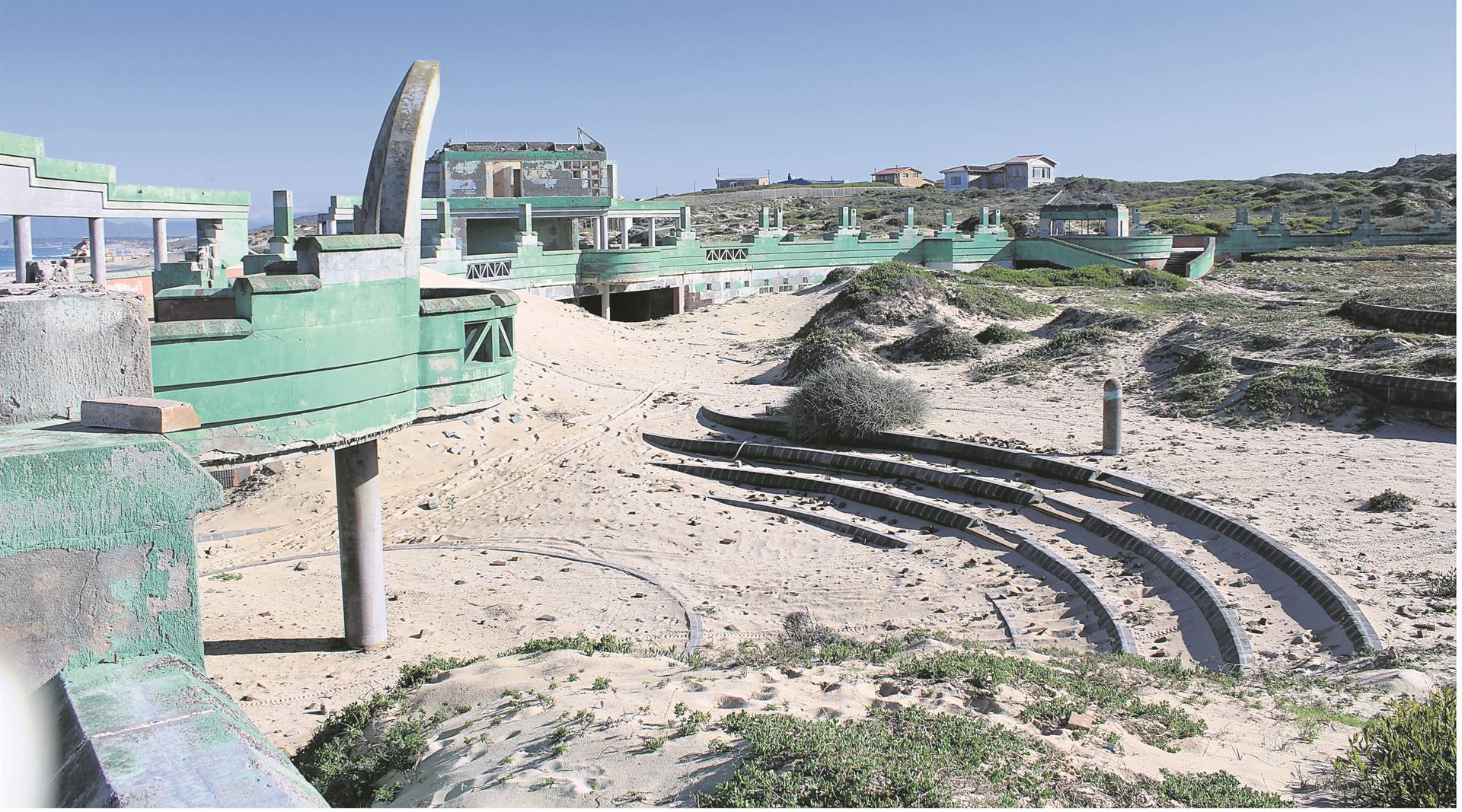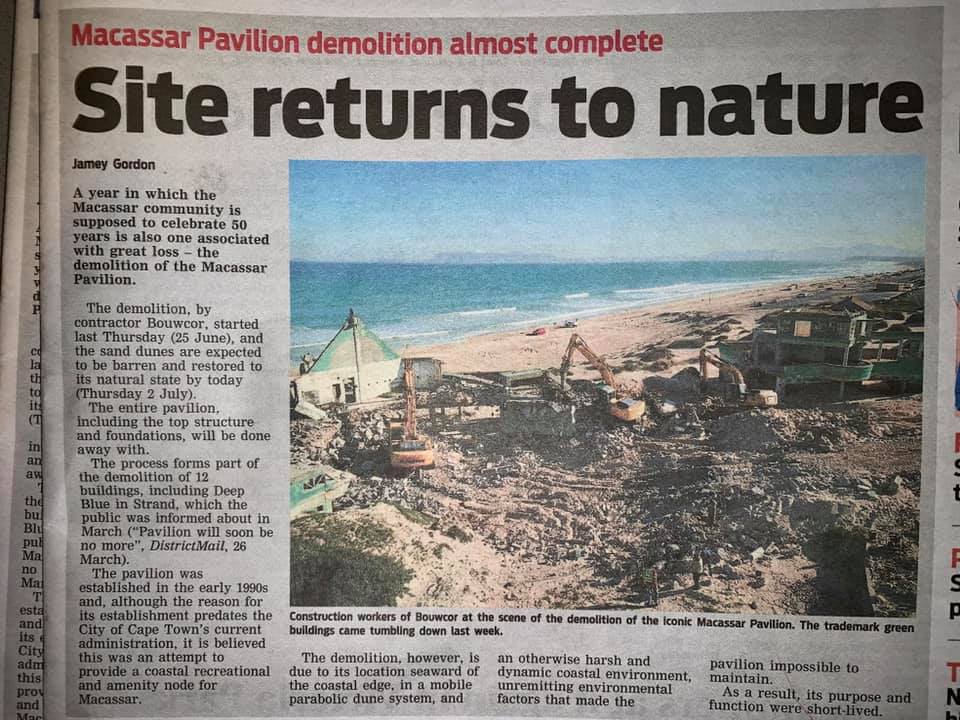Marian Nieuwoudt, Mayoral Committee (Mayco) member for Spatial Planning and Environment, this week confirmed the planned demolition of the Macassar Pavilion remains imminent, stating it had not yet been scheduled. She said the City is in the process of quantifying the works to establish an estimated demolition cost in an attempt to secure funding before the end of the financial year to start the demolition. Nieuwoudt explained the intention is to demolish the entire pavilion, including the top structure, foundations and all associated infrastructure.
The intended process forms part of the demolition of 12 buildings, including the Macassar Pavilion, which was advertised to the public in March last year and was on the respective sub-council agendas for meetings later in August.
“Once recommendations had been received by sub-council, a report was sent to council for a decision,” Nieuwoudt said. “Council supported the demolition of all 12 buildings, including the Macassar Pavilion. Following the support of council, the City’s Coastal Management department identified a term tender for the demolition, and obtained quotes from the contractor for each of the respective buildings. Once the cost had been determined for the demolition of each building the various demolitions were prioritised according to the budget available. The cost of the demolition for the Macassar Pavilion was extremely high, given that much of the building is buried in sand, it was difficult to estimate the demolition costs. The City has since requested the structure be better quantified for demolition, to determine a more accurate cost.
“The duration of the demolition cannot yet be determined, as the demolition has not yet been quantified. Once received, officials will be in a position to determine how much of the structure will be demolished and the expected time frames.”
The Mayco member further said visitors to the beach would not be impacted by the demolition, as all access to the beach can be taken from the current car park to the west of the pavilion at the Macassar Resort. Notwithstanding, access to the current structure will be restricted throughout the demolition process once it commences.
Although visitors to the beach may be left unaffected, this may not be the case for locals who treasure fond memories of the pavilion’s glory days. A prominent community member reckons the pavilion’s loss “will mark the end of a magnificent era in the history of Macassar. Part of the community’s soul will be plucked out and a beautiful scene forever wiped from their memories.
“It hurts so much more when we should be getting ready to celebrate, but are actually mourning the loss of one of Macassar’s most dominant structures and symbol of hope.” The community member believes the absolute minimum effort was made by the City to rescue the pavilion for Macassar and its people, and from utter deterioration.
The passionate community member regards the situation as even more devastating, for several families have had to relocate for the development of the pavilion and parking area. “Families received notices that they had to vacate their plots to make way for the development. Among these families were the Benjamins, Peters, Jacobs, Meyer, Samuels and Mitchells families. It was the early ’80s, and people of colour had no rights. It was move or be moved.”
However, Macassar residents embraced having their own place of beauty and entertainment to escape to, the community member recalled.
“People as far afield as Paarl and Atlantis would visit the pavilion in their droves,” the community member recalled. “It was thee place to come to over weekends and holidays.”
He also recalled problems arising when the encroachment of the sand dunes became a serious concern by 2000.
“The premises have largely been deserted since 2004, when the City decided it must return to its normal state. Today, almost 20 years later, the pavilion remains unused. The new generations are largely unaware of this once-magnificent beach entertainment gem. The demolition pains especially the older generation who know what a wonderful gathering point it was.”
The community member would rather have seen the pavilion revived, which he believes would have been possible if the City had acted sooner and focused on fighting the encroachment and stemming deterioration.
“I would implore the City not just to demolish the structure, but keep it alive in the minds and memories of the Macassar community by re-establishing the main arch, the pillars and some of the tombstones in Macassar or at the entrance to our town.”
According to Nieuwoudt the pavilion was established in the early 1990s and, although the reason for its establishment predates their current administration, it is believed this was an attempt to provide a coastal recreational and amenity node for the Macassar community.
For key role-players in its establishment (believed to be Regional Services Council), the cost of its development, the journey that culminated in its existence, predates their current administration, Nieuwoudt said, in response to an enquiry.
Nieuwoudt said the demolition of the Macassar Pavilion is due to its location seaward of the coastal edge, in a mobile parabolic dune system where it is continually inundated by windblown sand.
“A significant portion of the building and surrounding infrastructure lie buried beneath windblown sand, and are derelict and non-functional, and have been so for several years,” she explained. “It has also been structurally damaged due to erosion caused by a migrating estuary undercutting the dune.
“Given that it was built in a parabolic dune system, in an otherwise harsh and dynamic coastal environment, it was impossible to maintain due to these environmental factors. As a result its purpose and function were short-lived.”
On the question of why demolition was opted for, instead of the revival of the pavilion, Nieuwoudt said: “The structure is majorly deteriorated as a result of being built in an inappropriate location characterised by a harsh environment and dynamic coastal processes, which includes parabolic dune systems. It has also been subject to vandalism, resulting in the structure being derelict, non-functioning and a safety hazard to the general public. On inspection, it was confirmed the facility is economically obsolete, and given its location within a parabolic dune system and the harsh and dynamic coastal environment it is not feasible to rebuild.”
Nieuwoudt added the City regretted demolish what could have been a well-functioning recreational node, if it had been constructed in a more suitable location and not within a parabolic dune system, resulting in it not being a viable recreational node or sustainable.
“Inappropriate historical planning and decision making has led to the location of infrastructure in dynamic coastal spaces resulting in the inability to repair and maintain such structures in such harsh environments. Any redevelopment at the coast needs to take cognisance of natural coastal process and the sustainability of any future proposals to prevent making similar inappropriate planning decisions into the future.”
Nieuwoudt said demolition isn’t likely to impact the community, although its removal will assist in removing some of the social ills experienced in and around the structure. She said the City had no plans for the site because, “as noted above, the location is within a parabolic dune system and redevelopment in this location is not appropriate. Any future development within such a dynamic space is likely to suffer the same fate and, therefore, may be considered wasteful expenditure re-investing built infrastructure in this space. Removal of the structure will allow the parabolic dune and other coastal processes to function naturally.”
original article: https://www.netwerk24.com/ZA/Distrikspos/Nuus/pavilion-will-soon-be-no-more-20200325-2?fbclid=IwAR32NvSbjZFxRir7huL6s4fK24d0VKsCCkc3ezlXY2VCkV6_8u_0i8l-c8U



